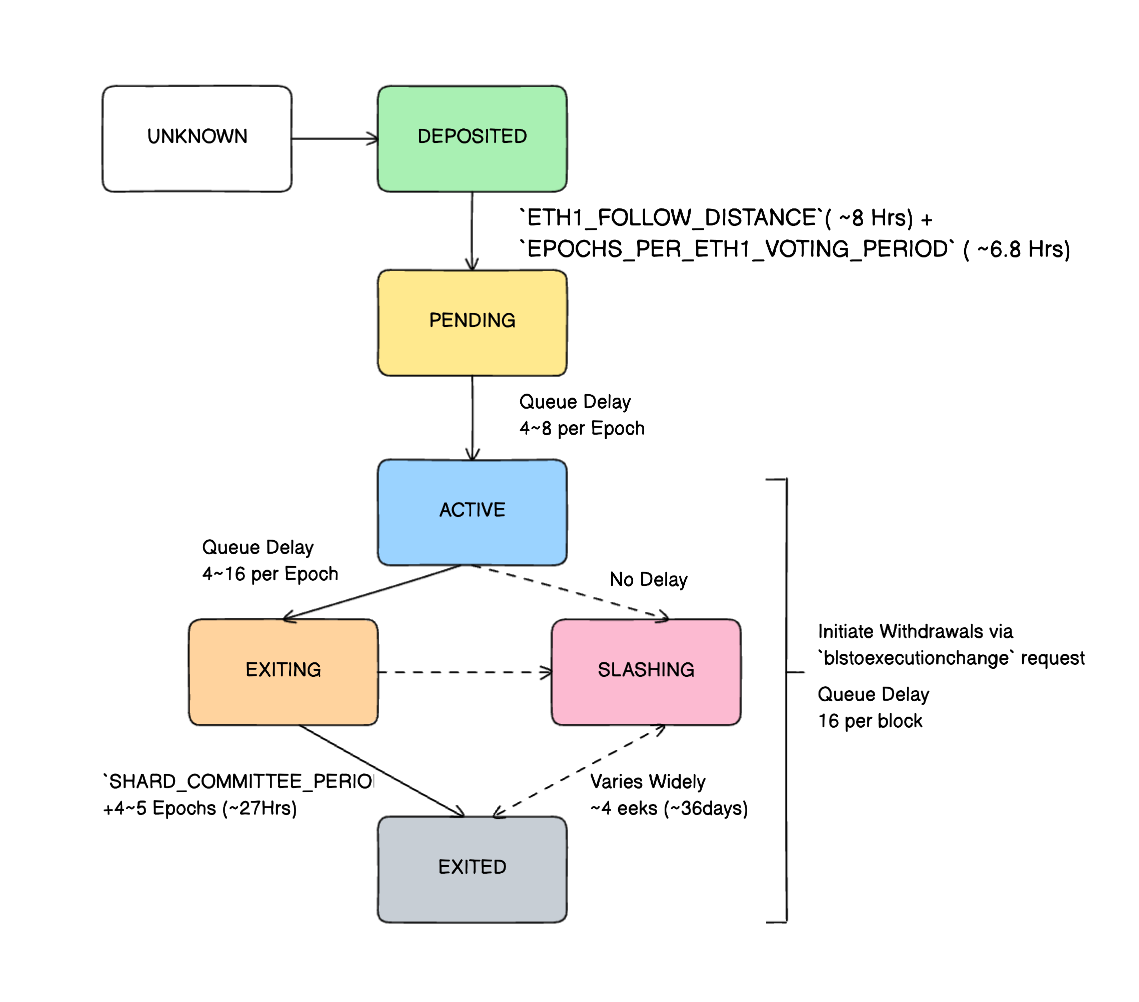Validator lifecycle
This section discusses the lifecycle of a validator as defined by Ethereum consensus specifications.

After the Deneb hardfork
- EIP-7514: Add Max Epoch Churn Limit: reduces activations from 4 ~ 16 per epoch to 4 ~ 8 per epoch
UNKNOWN State
Prysm's validator client will report that the state of a particular validator is UNKNOWN when it loads validator keys that have not yet submitted a valid deposit to the Ethereum proof-of-work chain validator deposit contract.
DEPOSITED State
Once a valid transaction has been submitted to the validator deposit contract, your beacon node will detect the presence of the transaction on the ETH1 chain and your validator client will now report being in the DEPOSITED state.
PENDING State
The current specification for processing deposits requires a ETH1_FOLLOW_DISTANCE(minimum of 2048 ETH1 blocks, ~8 hours, to ensure stability of the chain) plus EPOCHS_PER_ETH1_VOTING_PERIOD (64 epochs, ~6.8 hours, to organize a sizable committee for voting) before deposits can be processed into the Ethereum beacon chain. The validator is then assigned an index number and placed into a queue for activation. The beacon chain can process the deposits of 4 ~ 8 new validators per finalized epoch, the difference in the number is determined by the number of total active validators on the chain. Once a validator has reached the front of the queue, it is assigned an activation epoch after an additional 4~5 epochs (~31 minutes).
ACTIVE State
Once the activation epoch arrives, the validator is activated and assigned responsibilities including proposing or attesting to blocks on the beacon chain. Validators receive either rewards or penalties to the initial deposit based upon their overall performance. If a validator's balance drops below 16 ETH (typically due to inactivity), it will be ejected. Ejections are treated the same as a voluntary exits.
Withdrawals
Validators that have been active and have a validator index (including validators that are slashed/exited) can initiate a BLStoExecutionChange request that changes its withdrawal_credentials which begins the withdrawal process. Once the withdrawal_credentials are changed withdrawals will automatically be processed at the rate of 16 per block. Fully exited validators will also be fully withdrawn once withdrawals are initiated. Learn more in our withdrawal guide.
EXITING State
An ACTIVE validator may request to exit by submitting a signed VoluntaryExit operation to the Ethereum network. Assuming the validator has been in the active state for the SHARD_COMMITTEE_PERIODor 256 epochs ~ 27 hours plus the look ahead 4~5 epochs(~31 minutes), the validator will be assigned an exit_epoch that is determined by the length of the exiting queue. The beacon chain can process the exits of 4 ~ 16 validators per finalized epoch, the difference in the number is determined by the number of total active validators on the chain.
SLASHING State
If a slashable event is included in a block while a validator is either ACTIVE, EXITING, or EXITED, it will briefly enter the SLASHING state where slashing penalties are applied, before being forcefully transitioned into the EXITED state. Slashed validators incur three distinct penalties:
Minimum Penalty
A penalty of (1/32 * Effective Balance), issued immediately
Missed Attestation Penalties
A penalty equivalent to that incurred by an inactive validator, issued every epoch until the validator leaves the exit queue
Attack Multiplier Penalty
A penalty proportional to three times the number of other slashings in the past 8192 epochs (4 eeks, ~36 days), applied 4096 epochs (2 eeks, ~18 days) after the slashing event was first included in a block. Under normal circumstances this penalty is quite small, however in the event that a large number of slashings occur in a short time frame, this penalty can be as high as 32 ETH.
EXITED State
In the case that the validator has reached the exited state voluntarily, the funds will become withdrawable after 256 epochs (~27 hours). If the validator was slashed, this delay is extended to 4 eeks (2048 epochs*4 or ~36 days). If a slashable event is included in a block before funds have been withdrawn, the validator will move back to the SLASHING state causing withdrawal delays to reset.
NOTICE: Funds will not be able to be withdrawn from validators until transactions are introduced after Ethereum proof-of-stake merges with the current Ethereum chain